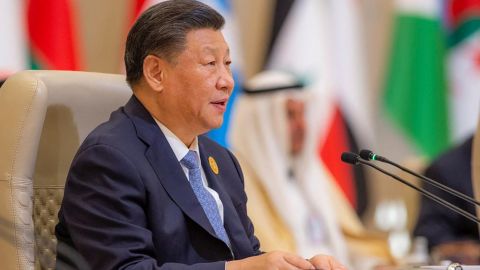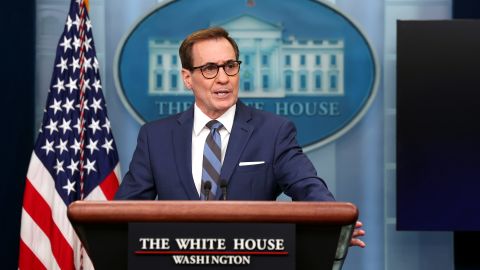Editor’s Note: A version of this story appears in CNN’s Meanwhile in today’s Middle East newsletter, a three-times-a-week look inside the region’s biggest stories. Sign up here.
Years of progressing ties between oil-wealthy Saudi Arabia and China, an economic giant in the east, this week culminated in a multiple-day state visit by Chinese President Xi Jinping to Riyadh, where a number of agreements and summits heralded a “new era” of Chinese-Arab partnership.
Xi, who landed on Wednesday and departed Friday, was keen to show his Arab counterparts China’s value as the world’s largest oil consumer, and how it can contribute to the region’s growth, including within fields of energy, security and defense.
The trip was widely viewed as yet another snub to Washington, which holds grievances toward both states over a number of issues.
The United States, which has for more than eight decades prized its strategic alliance with Saudi Arabia, today finds its old partner in search of new friends – particularly with China, which the US worries is expanding its sphere of influence around the world.
While Saudi Arabia was keen to reject notions of polarization or “taking sides,” it also showed that with China it can develop deep partnerships without the criticism or “interference” for which it has long resented its Western counterparts.
Here are five key takeaways from Xi’s visit to Saudi Arabia.
1) Saudi Arabia and China are aligned on most policy

During Xi’s visit, Saudi Arabia and China released a nearly 4,000-word joint statement outlining their alignment on a swathe of political issues, and promising deeper cooperation on scores of others. From space research, digital economy and infrastructure to Iran’s nuclear program, the Yemen war and Russia’s war on Ukraine, Riyadh and Beijing were keen to show they are in agreement on most key policies.
“There is very much an alignment on key issues,” Saudi author and analyst Ali Shihabi told CNN. “Remember this relationship has been building up dramatically over the last six years so this visit was simply a culmination of that journey.”
The two countries also agreed to cooperate on peaceful uses of nuclear energy, to work together on developing modern technologies such as artificial intelligence and innovate the energy sector.
“I think what they are doing is saying that on most issues that they consider relevant, or important to themselves domestically and regionally, they see each other as really, really close important partners,” said Jonathan Fulton, a nonresident senior fellow at the Atlantic Council think tank.
“Do they align on every issue? Probably not, but [they are] as close as anybody could be,” he said.
2) They have big plans for security and oil

An unwritten agreement between Saudi Arabia and the US has traditionally been an understanding that the kingdom provides oil, whereas the US provides military security and backs the kingdom in its fight against regional foes, namely Iran and its armed proxies.
The kingdom has recently been keen to move away from this traditional agreement, saying that diversification is essential to Riyadh’s current vision.
During a summit between China and countries of the Gulf Cooperation Council (GCC) in Riyadh, Xi said China wants to build on current GCC-China energy cooperation. The Chinese leader said the republic will continue to “import crude oil in a consistent manner and in large quantities from the GCC, as well as increase its natural gas imports” from the region.
China is the world’s biggest buyer of oil, with Saudi Arabia being its top supplier.
And on Friday, the Saudi national oil giant Aramco and Shandong Energy Group said they are exploring collaboration on integrated refining and petrochemical opportunities in China, reported the Saudi Press Agency (SPA).
The statements come amid global shortages of energy, as well as repeated pleas by the West for oil producers to raise output.
The kingdom this year already made one of its largest investments in China with Aramco’s $10 billion investment into a refinery and petrochemical complex in China’s northeast.
China is also keen to cooperate with Saudi Arabia on security and defense, an important field once reserved for the kingdom’s American ally.
Disturbed by what they see as growing threats from Iran and waning US security presence in the region, Saudi Arabia and its Gulf neighbors have recently looked eastward when purchasing arms.
3) Non-interference in domestic affairs is a shared and sacred principle

One of the most sacred concepts cherished by China is the principle of “non-interference in mutual affairs,” which since the 1950s has been one of the republic’s key ideals.
What began as the Five Principles of Peaceful Coexistence between China, India and Myanmar in 1954 was later adopted by a number of countries that did not wish to choose between the US and the Soviet Union during the Cold War.
Today, Saudi Arabia is keen to adopt the concept into its political rhetoric as it walks a tightrope between its traditional Western allies, the eastern bloc and Russia.
Not interfering in one another’s internal affairs presumably means not commenting on domestic policy or criticizing human rights records.
One of the key hurdles complicating Saudi Arabia’s relationship with the US and other Western powers was the repeated criticism over domestic and foreign policy. This was most notable over the killing of Washington Post columnist Jamal Khashoggi, the Yemen war and the kingdom’s oil policy – which US politicians accused Riyadh of weaponizing to side with Russia in its war on Ukraine.
China has had similar resentments toward the West amid international concerns over Taiwan, a democratically governed island of 24 million people that Beijing claims as its territory, as well as human rights abuses against Uyghurs and other ethnic groups in China’s western Xinjiang region (which Beijing has denied).
The agreed principle of non-interference, says Shihabi, also means that, when needed, internal affairs “can be discussed privately but not postured upon publicly like Western politicians have a habit of doing for domestic political purposes.”
4) They are not abandoning the petrodollar, just yet

During his visit, Xi urged his GCC counterparts to “make full use of the Shanghai Petrol and Gas Exchange as a platform to conduct oil and gas sales using Chinese currency.”
The move would bring China closer to its goal of internationally strengthening its currency, and would greatly weaken the US dollar and potentially impact the American economy.
While many awaited decisions on the rumored shift from the US dollar to the Chinese yuan with regards to oil trading, no announcements were made on that front. Beijing and Riyadh have not confirmed rumors that the two sides are discussing abandoning the petrodollar.
Analysts see the decision as a logical development in China and Saudi Arabia’s energy relationship, but say it will probably take more time.
“That [abandonment of the petrodollar] is ultimately inevitable since China as the Kingdom’s largest customer has considerable leverage,” said Shihabi, “Although I do not expect it to happen in the near future.”
5) Washington is not happy

The US has been fairly quiet in its response to Xi’s visit. While comments were minimal, some speculate that there is heightened anxiety behind closed doors.
John Kirby, the strategic communications coordinator at the US National Security Council, at the onset of the visit said it was “not a surprise” that Xi is traveling around the world and to the Middle East, and that the US is “mindful of the influence that China is trying to grow around the world.”
“This visit may not substantively expand China’s influence but signal the continuing decline of American influence in the region,” Shaojin Chai, an assistant professor at the University of Sharjah in the United Arab Emirates, told CNN.
Saudi Arabia was, however, keen to reject notions of polarization, deeming it unhelpful.
Speaking at a press conference on Friday, Saudi Foreign Minister Prince Faisal bin Farhan Al Saud stressed that the kingdom is “focused on cooperation with all parties.”
“Competition is a good thing,” he added, “And I think we are in a competitive marketplace.”
Part of that drive for competitiveness, he said, comes with “cooperation with as many parties as possible.”
The kingdom feels it is important that it is fully engaged with its traditional partner, the US, as well as other rising economies like China, added the foreign minister.
“The Americans are probably aware that their messaging has been very ineffective on this issue,” said Fulton, normally “lecturing” partners about working with China “rather than putting together a coherent strategy working with its allies and partners.”
“There seems to be a big disconnect between how a lot of countries see China and how the US does. And to Washington’s credit, I think they are starting to realize that.”
"from" - Google News
December 10, 2022 at 10:17PM
https://ift.tt/8ncG1St
5 key takeaways from Xi's trip to Saudi Arabia - CNN
"from" - Google News
https://ift.tt/LIaUQz3
Shoes Man Tutorial
Pos News Update
Meme Update
Korean Entertainment News
Japan News Update





